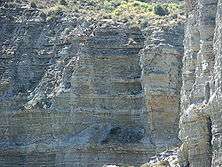Cyclostratigraphy

Cyclostratigraphy is the study of astronomically forced climate cycles within sedimentary successions.[1] Astronomical cycles are variations of the Earth's orbit around the sun due to the gravitational interaction with other masses within the solar system. Due to this cyclicity solar irradiation differs through time on different hemispheres and seasonality is affected. These insolation variations have influence on earth's climate and so on the deposition of sedimentary rocks.
The main orbital cycles are precession with at present main periods of 19 and 23 kyr, obliquity with at present main periods of 41 kyr, and 1.2 Myr, and eccentricity with at present main periods of around 100 kyr, 405 kyr, and 2.4 Myr.[2]
Cyclostratigraphic study of rock records can lead to accurate dating of events in the geological past, to increase understanding of cause and consequences of earth's (climate) history, and to more control on depositional mechanisms of sediments and the acting of sedimentary systems.
See also
References
- ↑ Andre Strasser, Frederik Hilgen, Philip H. Heckel. "Cyclostratigraphy - from orbital cycles to geologic time scale". 2008. http://www.cprm.gov.br/33IGC/1312131.html
- ↑ Hinnov L.A. & Ogg J.G. (2007). "Cyclostratigraphy and the Astronomical Time Scale" (PDF). Stratigraphy. 4 (2-3): 239–251.
- Isabelle Cojan et Maurice Renard, Sédimentologie, 2e éd., Dunod, 2006, ISBN 2-10-049623-9 (French)
- Graham P. Weedon, Time-Series Analysis And Cyclostratigraphy: Examining Stratigraphic Records of Environmental Cycles, Cambridge University Press, 2005 ISBN 0-521-01983-4 (English)
- André Berger, Le climat de la Terre — Un passé pour quel avenir ?, De Boeck université, 1992, ISBN 2-8041-1497-X (French)
- Brigitte Van Vliet-Lanoë, La planète des glaces — Histoire et environnements de notre ère glaciaire, Vuibert, 2005, ISBN 2-7117-5377-8 (French)
- Patrick de Wever, Loïc Labrousse, Daniel Raymond, André Schaaf, La mesure du temps dans l'histoire de la Terre, Société géologique de France, édité par Vuibert, 2005, ISBN 2-7117-5393-X (French)